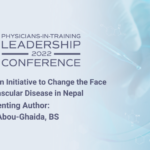Abstract | April 5, 2022
“Healthy Heart” An initiative to change the face of Cardiovascular Disease in Nepal
Learning Objectives
- A Cardiovascular health crisis and burden exists in Nepal;
- Implementing a standardized protocol for hypertension diagnosis in doctors' offices will eventually influence policy and combat the high population of undiagnosed hypertensive individuals;
- Health literacy is pertinent to a country-wide change in how hypertension and related cardiovascular risk factors are perceived, diagnosed and treated.
Non-communicable, progressive diseases are often underdiagnosed but have potentially disastrous consequences on quality of life and workforce productivity. Hypertension, in particular, has taken precedence in research studies in Nepal in an effort to understand its prevalence, impact, and control. Risk factors and barriers of hypertension in Nepal have been identified via studies conducted between 2017-2021. A common set of conclusions reached by most studies were that hypertension tends to be pervasive; awareness of its harmful effects is low; and managing it seems to be subpar. It is difficult to address the issue of declining cardiovascular health in aging individuals when approximately 50% have undiagnosed hypertension. In addition, there has been little progress towards improving the status of hypertensive care. Hypertension is one of the main risk factors associated with cardiovascular disease, and standardized approaches to assessment and treatment are crucial to preventing future complications.
We would like to create educational material and a screening protocol for primary care centers to ultimately influence policy in favor of cardiovascular disease prevention and treatment. The goal of our initiative is to raise awareness, promote healthier lifestyles, and create replicable protocols for doctor’s offices to standardize their cardiovascular care. With sustainable procedures, we can more accurately screen and diagnose cardiovascular precursors to prevent irreversible complications. We will survey the current Community Health Centers to establish a baseline of current practices to develop guidelines that will fill the gaps in current care. The general population of Nepal will also be surveyed for their understanding of hypertension, potential risk factors, and common sequelae.
Our desired outcomes are to increase health literacy on risk factors, progression, and consequences of untreated cardiovascular disease, as well as the importance of exercise and healthy diets. We also aim to establish guidelines and a protocol to be implemented in doctors’ offices. Education and standardized procedures will reduce the public health and economic burden of cardiovascular disease in Nepal.
References and Resources:
- Hasan MM, Tasnim F, Tariqujjaman M, et alExamining the prevalence, correlates and inequalities of undiagnosed hypertension in Nepal: a population-based cross-sectional studyBMJ Open 2020;10:e037592. doi: 10.1136/bmjopen-2020-037592

